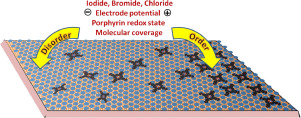当前位置:
X-MOL 学术
›
Surf. Sci.
›
论文详情
Our official English website, www.x-mol.net, welcomes your
feedback! (Note: you will need to create a separate account there.)
Self-assembly of porphyrin molecules on a Cu(111) electrode: Influence of different anions and electrode potential
Surface Science ( IF 2.1 ) Pub Date : 2020-04-01 , DOI: 10.1016/j.susc.2019.121554 Thi Mien Trung Huynh , Thanh Hai Phan , Phi Hung Nguyen , Klaus Wandelt
Surface Science ( IF 2.1 ) Pub Date : 2020-04-01 , DOI: 10.1016/j.susc.2019.121554 Thi Mien Trung Huynh , Thanh Hai Phan , Phi Hung Nguyen , Klaus Wandelt

|
Abstract In this contribution, we provide a view on the role of halide interlayers in the self-assembly of layers of organic molecules at metal-electrolyte interfaces with molecular resolution. In particular, the ordering of tetra(4-trimethylammoniophenyl) porphyrin molecules in cationic form, abbreviated as [H2TTMAPP]4+, has been studied on a Cu(111) electrode surface in aqueous solution containing chloride-, bromide- or iodide-anions using a combination of cyclic voltammetry (CV) and in-situ electrochemical scanning tunneling microscopy (EC-STM). On the one hand the obtained results unveil that the degree of ordering of the self-assembled layer of [H2TTMAPP]4+ cations on the Cu(111) surface changes significantly when changing the halide anion in the working electrolyte, and, thereby, the buffer layer between the Cu(111) surface and the adsorbed [H2TTMAPP]4+ molecular cations. Under the same experimental conditions a fully ordered layer is observed on the chloride precovered Cu(111) surface, but less ordering and even incomplete monolayer formation are found on the bromide and iodide terminated Cu(111) surface, respectively; the degree of order decreases with decreasing electronegativity of the underlying halide. On the other hand potential driven reduction of the organic species lowers the charge density of the organic cations themselves causing a desorption of the reduced molecules at even lower potentials from any of the three differently halide modified electrode surfaces. Both observations underline the importance of electrostatic interactions in the adsorption and structure formation of the porphyrin molecules on the halide modified surfaces.
中文翻译:

卟啉分子在 Cu(111) 电极上的自组装:不同阴离子和电极电位的影响
摘要 在这篇文章中,我们提供了关于卤化物夹层在金属-电解质界面处有机分子层自组装中的作用的观点,并具有分子分辨率。特别是,在含有氯化物、溴化物或碘化物阴离子的水溶液中,在 Cu(111) 电极表面上研究了阳离子形式的四(4-三甲基氨基苯基)卟啉分子的排序,缩写为 [H2TTMAPP]4+使用循环伏安法 (CV) 和原位电化学扫描隧道显微镜 (EC-STM) 的组合。一方面,所得结果表明,当改变工作电解质中的卤化物阴离子时,Cu(111) 表面上 [H2TTMAPP]4+ 阳离子的自组装层的有序度发生显着变化,因此,Cu(111) 表面和吸附的 [H2TTMAPP]4+ 分子阳离子之间的缓冲层。在相同的实验条件下,在氯化物预覆盖的 Cu(111) 表面上观察到完全有序的层,但在溴化物和碘化物封端的 Cu(111) 表面上分别发现有序性较低甚至不完整的单层形成;有序度随着底层卤化物的电负性降低而降低。另一方面,有机物质的电位驱动还原降低了有机阳离子本身的电荷密度,导致还原分子在更低电位下从三种不同卤化物改性的电极表面中的任何一个上解吸。
更新日期:2020-04-01
中文翻译:

卟啉分子在 Cu(111) 电极上的自组装:不同阴离子和电极电位的影响
摘要 在这篇文章中,我们提供了关于卤化物夹层在金属-电解质界面处有机分子层自组装中的作用的观点,并具有分子分辨率。特别是,在含有氯化物、溴化物或碘化物阴离子的水溶液中,在 Cu(111) 电极表面上研究了阳离子形式的四(4-三甲基氨基苯基)卟啉分子的排序,缩写为 [H2TTMAPP]4+使用循环伏安法 (CV) 和原位电化学扫描隧道显微镜 (EC-STM) 的组合。一方面,所得结果表明,当改变工作电解质中的卤化物阴离子时,Cu(111) 表面上 [H2TTMAPP]4+ 阳离子的自组装层的有序度发生显着变化,因此,Cu(111) 表面和吸附的 [H2TTMAPP]4+ 分子阳离子之间的缓冲层。在相同的实验条件下,在氯化物预覆盖的 Cu(111) 表面上观察到完全有序的层,但在溴化物和碘化物封端的 Cu(111) 表面上分别发现有序性较低甚至不完整的单层形成;有序度随着底层卤化物的电负性降低而降低。另一方面,有机物质的电位驱动还原降低了有机阳离子本身的电荷密度,导致还原分子在更低电位下从三种不同卤化物改性的电极表面中的任何一个上解吸。











































 京公网安备 11010802027423号
京公网安备 11010802027423号